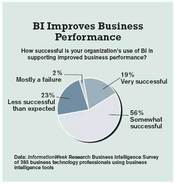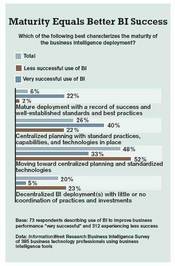Seven Steps to Successful BI Competency Centers
From setting a strategic vision and gaining C-level support to promoting successes and responding to emergencies, follow these seven suggestions for developing BICCs that boost business performance.

Maturity and success often go hand in hand. That's as true for business intelligence (BI) deployments as it is for people.
In a recent survey of 358 business technology professionals conducted by InformationWeek and Intelligent Enterprise.com, two thirds of the respondents who rated their BI deployments as "very successful" (see "BI Improves Business Performance" chart) also said those deployments are "mature" or at least "centralized" in their approach. In contrast, three quarters of those who reported less success ranked their deployments as either "just moving toward centralization" or stuck in "decentralized deployments with little or no coordination of practices and investments" (see "Maturity Equals Better BI Success" chart)

BI Improves Business Performance
(click image for larger view)
How do you move toward a mature BI deployment — one in which proven practices as well as technologies are shared across the organization? BI Competency Centers (BICCs) or BI Centers of Excellence are the answer for many firms. The very act of creating a cross-disciplinary team aimed at sharing competencies and investments is a sure sign that the organization is moving away from a dysfunctional departmental approach.

Maturity Equals Success
(click image for larger view)
Creating and maintaining a BICC is no simple task, but a well-balanced and empowered group can change the corporate culture and align decision making with high-level strategic goals. This article presents steps that will promote BICC success together with real-world examples and tips from BICC veterans.
1. Start with a strategic mission.
Don't think of it as a "BI Technology Center"; the BICC should be a repository of knowledge and capabilities around BI applications and priorities. Most importantly, the mission should be guided by high-level strategic goals that cut across the organization.
"The whole point is making it strategic and repeatable," says Gartner analyst Bill Hostmann. "The BICC should promote the idea of using information to make better decisions and to manage the performance of the business."
Work with the BICC team to clearly spell out a written charter that will guide the BICC and make the mission clear to others. The BICC can then promote a shared vision, shared approach and shared technologies whether the project(s) at hand deals with the call center, marketing, financial management, the supply chain, manufacturing or human resource initiatives.
2. Get C-level support.
Without high-level sponsorship and authority to act (see step three), the BICC simply won't have an impact. That said, you have to choose leadership carefully. CIOs often lead BICCs, but that can "send the wrong message that it's an IT initiative," says Aiman Zeid, BICC lead consultant at SAS. "The objective of the competency center should be to embed BI into the daily operation of the company."
To best promote collaboration between business and IT, an ideal choice to sponsor the BICC would be the COO, Zeid says. CFOs or CMOs can make effective BICC sponsors, but don't be surprised if the focus turns toward financial or marketing goals, respectively.
Contrary to suggested best practices, about 67 percent of BICCs report up trough IT, according to research conducted last year by Cognos, an IBM company. In contrast, 29 percent report up through the business, typically through the CFO or CMO. What about the remaining 4 percent?
"We're increasingly seeing partnerships between the COO and the CFO as well as CFOs and CIO," says Michael Dziekan, global program director, BICC at Cognos. "We're also watching the emergence of the CSO — a Chief Strategy Officer who is accountable to pull together business and IT as one."
At a minimum, the BICC should have executive sponsorship from a vice president of IT or vice president of finance, but it's better if it's a senior VP or a VP with C-level backing, says Dzeikan. "We often see passionate VP or director sponsors who are saying 'I know we can do better, but I haven't quite convinced my C-level executive or the Board that we need to formalize the BICC."
3. Structure and fund appropriately.
BICC should comprise a mix of business skills, analytic skills, IT skills and program-management skills. The idea is to help the technologists understand what's vital to the business while business people and analysts get a sounding board to know what's technically possible and realistic.
At MassHousing, a Massachusetts-owned bank that lends money to low- and moderate-income residents at below market rates, a six-person BICC with a blend of skills. "We're essentially a committee that sits between the business and IT," says Carl Richardson, BI project manager. "Four of us have IT and technical experience and two of us came out of the business."
MassHousing's BICC was formerly under IT, but the group lobbied for and won independence. It's now headed by one of the two business people and it reports up through the Manager and Director of Administration, a key business leader. "When we were under IT, everyone was considered a developer, which is an inaccurate name for what happens in BI," Richardson says. "We're as much analysts and politicians as we are developers, so we now have titles that are more in line with the [BICC]."
A good mix of expertise and independence from IT and other departments encourages broader adoption, but BICC's also need adequate funding for both people and infrastructure. "A centrally funded BICC removes a barrier to business adoption," Dziekan of Cognos explains. "If you have to say, 'we're ready to help, but you have to buy new licenses and budget for servers, rack space and training,' the business units might just walk away and try to do something on their own."
Cognos has helped more than 300 customers structure and manage BICCs, and Dziekan says staffing ranges from 32 full-time people at Boeing and 16 at AmGen down to part-time BICC work for participating executives and team members at small and midsize companies.
4. Prepare for ongoing support.
A BICC is not a once-and-done project or even a series of projects. Think of it as a program demanding operational support, monitoring of success, and ongoing advice and assistance as business needs change. That said, staffing and activity levels will change along with the ebb and flow of projects.
"A bunch of people are involved up front in the vision, planning and building phases, and that would include the architects, developers and IT folks," Hostmann of Gartner explains. "A dynamic set of skills are brought in and combined with the team at different phases, and the program manager has to arrange for the right skills for the right activities."
Gartner describes a formal vision-plan-build-operate BICC activity cycle. The "operate" phase is about ongoing monitoring and course correction. At Hartford Life, an autonomous, 11-person "BI Group" reporting up through the chief of staff is focused on analytics, reporting and dashboarding. A main goal of the group is repeating successes in predictive modeling. As an example, a fine-grained customer segmentation developed last year for the call center was also applied by the company's asset retention team, according to Jennifer Golec, director of quantitative analytics.
"A lot of the predictive modeling in insurance is all around segmentation and trying to find niches," Golec explains. "One project will often get us thinking about new ways to segment customers, be it around products or even the insurance brokers they're using."
One ongoing roll for the BI Group is updating models as the business changes. "There are models scattered all around the company," Golec says. "A lot of them require ongoing work, be it conversion models on our personal [insurance] lines, segregation and fraud models on our claims side or risk models on our actuarial side."
SAS's Zeid says the hiring of an analytic consultant (Golec's role at SAS customer Hartford Life) is a good indication that the business is using the technology to run the business. "The most effective deployment and use of BI is based on a process or program mentality that never ends," he adds.
5. Establish authority and make tough choices.
BICCs must have the clout to make technology choices and standardization decisions. Mavericks and prima donnas may want to cling to their ways, but you can't repeat success with a disparate patchwork of approaches, tools and training requirements.
"A lack of tool standards certainly limits the portability of applications," says Claudia Imhoff, founder and president of BI consultancy Intelligent Solutions. "Without standards, you'll require more training, it limits collaboration, it increases software licensing costs and it may also require redundant capabilities if the technologies aren't compatible."
In short, the BICC must be able to make choices that stick. "If you have the responsibility but not the authority to change anything, your BICC will be rudderless and ineffective," says Imhoff. Here again a cross-functional team and executive-level support is essential to establishing authority.
6. Communicate goals and successes.
BICC successes won't multiply unless you sell the BICC. Whatever you call the group, you have to promote it, its mission and each and every success.
"The communication plan starts with the launch of the BICC, articulating what it is and what it is not," says Dziekan of Cognos. "The second most-important communication goal is creating a sense of community and celebrating successes that are shared by business and IT. That gets people talking and inquiring whether they can join in the success."
Newsletters, intranet sites, portal pages and presentations are the typical outlets for success stories. Be sure to detail the technologies used, the deployment timeline and the key contributors on both the business and IT sides (particularly if they serve on the BICC). Also detail tangible and intangible benefits and, if it's not too sensitive, the budget and certainly the costs and tasks shouldered by the BICC.
7. Be responsive.
Be prepared to drop everything and deal with urgent demands and requests.
"If the director or deputy director calls down tomorrow and says he needs to solve a problem with a report, we change gears without hesitation," says Richardson of MassHousing. As an example, the MassHousing BICC last year quickly launched a BI-related initiative to support rescue loans soon after the credit crunch and sub-prime mortgage meltdown hit. The BI part involved identifying and grading the severity of distressed loans, and the project was put on the fast track.
"There will always be situations in which the business says, 'we have to get this report or this analytic or this application crated immediately,'" says Imhoff of Intelligent Solutions. "There has to be a process in place to recognize emergencies and go outside the normal process. Otherwise, the business is going to make an end run around the BICC."
If the business finds another way, then the ultimate BICC goal of repeating successes and avoiding the same mistakes goes straight out the window.
About the Author
You May Also Like






